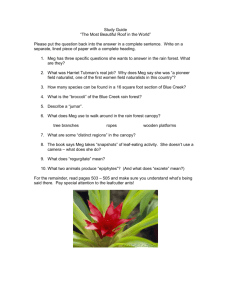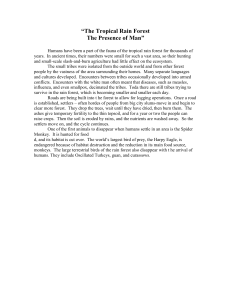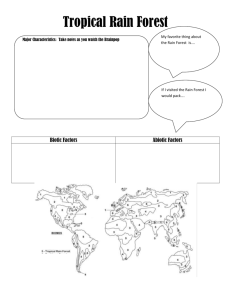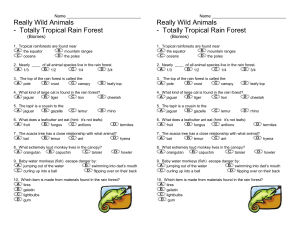Interdisciplinary
advertisement
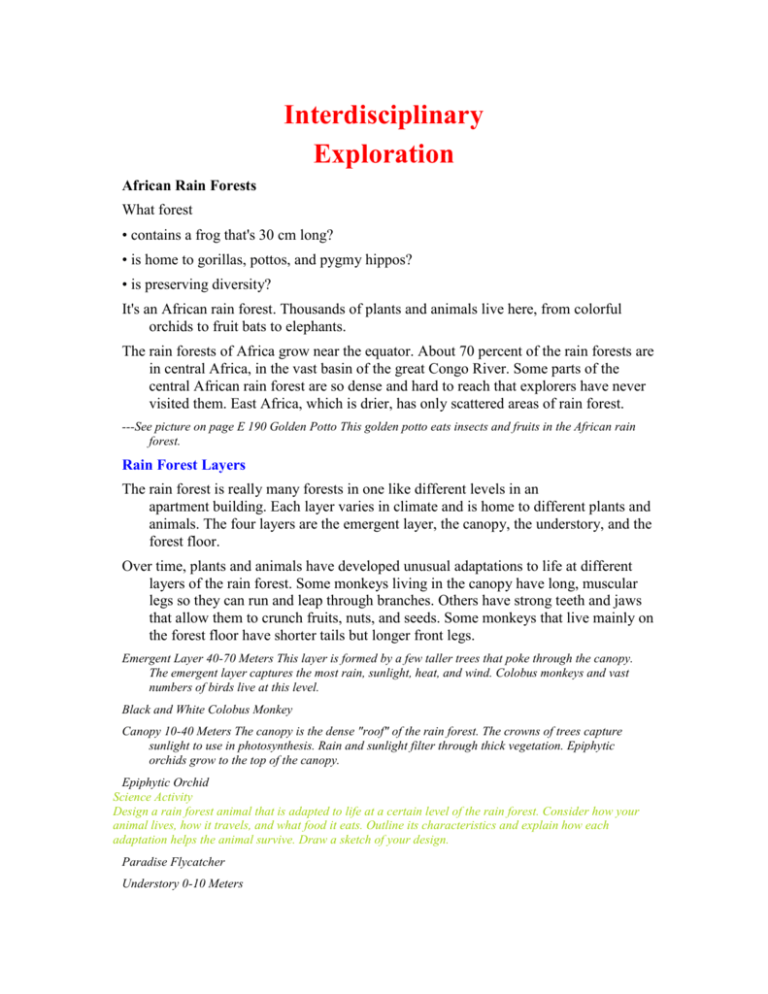
Interdisciplinary Exploration African Rain Forests What forest • contains a frog that's 30 cm long? • is home to gorillas, pottos, and pygmy hippos? • is preserving diversity? It's an African rain forest. Thousands of plants and animals live here, from colorful orchids to fruit bats to elephants. The rain forests of Africa grow near the equator. About 70 percent of the rain forests are in central Africa, in the vast basin of the great Congo River. Some parts of the central African rain forest are so dense and hard to reach that explorers have never visited them. East Africa, which is drier, has only scattered areas of rain forest. ---See picture on page E 190 Golden Potto This golden potto eats insects and fruits in the African rain forest. Rain Forest Layers The rain forest is really many forests in one like different levels in an apartment building. Each layer varies in climate and is home to different plants and animals. The four layers are the emergent layer, the canopy, the understory, and the forest floor. Over time, plants and animals have developed unusual adaptations to life at different layers of the rain forest. Some monkeys living in the canopy have long, muscular legs so they can run and leap through branches. Others have strong teeth and jaws that allow them to crunch fruits, nuts, and seeds. Some monkeys that live mainly on the forest floor have shorter tails but longer front legs. Emergent Layer 40-70 Meters This layer is formed by a few taller trees that poke through the canopy. The emergent layer captures the most rain, sunlight, heat, and wind. Colobus monkeys and vast numbers of birds live at this level. Black and White Colobus Monkey Canopy 10-40 Meters The canopy is the dense "roof" of the rain forest. The crowns of trees capture sunlight to use in photosynthesis. Rain and sunlight filter through thick vegetation. Epiphytic orchids grow to the top of the canopy. Epiphytic Orchid Science Activity Design a rain forest animal that is adapted to life at a certain level of the rain forest. Consider how your animal lives, how it travels, and what food it eats. Outline its characteristics and explain how each adaptation helps the animal survive. Draw a sketch of your design. Paradise Flycatcher Understory 0-10 Meters The understory has trees and plants that need little light. Pythons lurk in the vegetation. Some small animals such as squirrels glide from branch to branch. Forest Floor 0 Meters The forest floor is dark and humid. Pygmy hippos forage for food on the forest floor. Pygmy hippos are just one tenth the size of common hippos. Pygmy Hippo E 191 Mathematics Reaching for Sunlight Most rain forest trees are evergreens with broad leathery leaves. Some, like the African yellowwood, are conifers. Because the forest is so dense, trees must grow tall and straight to reach sunlight at the top of the canopy. Along rivers, the floor and understory of the rain forest are a tangle of thick vegetation. But deep in the rain forest the floor is surprisingly bare. The canopy trees prevent sunlight from reaching plants below. Water drips from the leaves of the canopy high overhead. Young trees have the best chance to grow when older trees fall and open up sunny clearings. West Africa's tropical forests contain many valuable trees. African mahogany and teak are used to make furniture, tools, and boats. Oil from the oil palm is used in soaps, candles, and some foods. Trees, such as ebony, that can tolerate shade grow slowly and develop dark, hard, long-lasting wood. ---See picture on page E 192 Rain Forest Tree Rain forest trees like this kapok tree grow straight up toward the sun. Math Activity The table on this page gives the height of some of the trees in the rain forest. Use the information in the table to make a bar graph. Label the horizontal axis with the tree names. Use the vertical axis to show the heights of the trees. • Which tree has the greatest maximum height? The least maximum height? • What is the difference between the maximum heights of the tallest and the shortest trees? • What is the average maximum height of all the trees shown in the graph? 192 E ---Bark Cloth Traditional Mbuti clothing is made of bark cloth. Ituri Forest People The native peoples of the African rain forest live as they have for thousands of years by hunting and gathering. The forest supplies them with everything they need— food, water, firewood, building materials, and medicines. One group of rain forest dwellers is the Mbuti people. The Mbuti live in the Ituri forest of the Democratic Republic of the Congo. Many of the Mbuti are quite small. The men hunt game, such as gazelle and antelope. The women gather wild fruits, nuts, and greens. Their traditional Mbuti clothing is made of tree bark and is wrapped around the waist. The bark is beaten to make it soft. Then it's decorated with geometric designs. ---The Mbuti The Mbuti hunt and fish along the Congo River. Most Mbuti live as nomads, with no settled home. Every few months they set up new hunting grounds. They build temporary dome-shaped huts of branches and leaves. Hunting groups of about 10 to 25 families live together. Modern Africa has brought changes to the forest people, especially for those who live near the edges of the rain forest. For a few months of the year, some Mbuti work as laborers for farmers who live in villages at the edge of the forest. When their work is finished, the Mbuti return to the Ituri forest. Most forest people prefer not to cultivate their own land. Since the farmers don't hunt, they trade their goods for meat. In exchange for meat, the Mbuti receive goods such as iron tools, cooking pots, clothes, bananas, and other farm produce. Social Studies Activity List the goods that forest people and farmers might have to trade. Assume that no modern conveniences, such as tractors and stoves, are available. In writing, explain how goods might be exchanged. Assign a value to the farmers' goods and the Mbuti goods, depending upon each group's needs. How would the trading process change if money were exchanged? E 193 Language Arts climbing the Canopy Much of the rain forest is still a mystery because it's so difficult for scientists to study the canopy. Native forest people sometimes climb these tall trees using strong, thick vines called lianas as support. But rain forest scientists have had to find different methods. Naturalist Gerald Durrell, working in the African rain forest, was lucky enough to find another way to observe the canopy. He describes it here. ---Gerald Durrell British conservationist Gerald Durrell wrote about his adventures with wildlife around the world. In this photo, Durrell holds an anteater. While the canopy is one of the most richly inhabited regions of the forest it is also the one that causes the naturalist the greatest frustration. There he is, down in the gloom among the giant tree trunks, hearing the noises of animal life high above him and having half-eaten fruit, flowers, or seeds rained on him by legions of animals high in their sunlit domain—all of which he cannot see. Under these circumstances the naturalist develops a very bad temper and a permanent crick in the neck. However, there was one occasion when I managed to transport myself into the forest canopy, and it was a magical experience. It happened in West Africa when I was camped on the thickly forested lower slopes of a mountain called N'da Ali. Walking through the forest one day I found I was walking along the edge of a great step cut out of the mountain. The cliff face, covered with creepers, dropped away for about 50 yards, so that although I was walking through forest, just next to me and slightly below was the canopy of the forest growing up from the base of the cliff. This cliff was over half a mile in length and provided me with a natural balcony from which I could observe the treetop life simply by lying on the cliff edge, concealed in the low undergrowth. Over a period of about a week I spent hours up there and a whole pageant of wildlife passed by. The numbers of birds were incredible, ranging from minute glittering sunbirds in rainbow coloring, zooming like helicopters from blossom to blossom as they fed on the nectar, to the flocks of huge black hornbills with their monstrous yellow beaks who flew in such an ungainly manner and made such a noise over their choice of forest fruits. From early morning to evening when it grew too dark to see, I watched this parade of creatures. Troops of monkeys swept past, followed by attendant flocks of birds who fed eagerly on the insects that the monkeys disturbed during their noisy crashing through the trees. Squirrels chased each other, or hotly pursued lizards, or simply lay spread-eagled on branches high up in the trees, enjoying the sun. Language Arts Activity Besides being an experienced naturalist and writer, Gerald Durrell was also a careful observer. In this selection, he describes in detail the "magical experience" of being in the canopy. Reread Durrell's description. Now work with a partner to write and design a pamphlet that will persuade visitors to come to an African rain forest. For your pamphlet, write strong, lively descriptions of what you might see, hear, and experience. Be persuasive. Tie it Together Celebrate Diversity Rain forests have the greatest biodiversity variety of plant and animal life—of any ecosystem on Earth. Many species have yet to be discovered! Plan a display for your school to celebrate biodiversity in the rain forests. Include drawings, photos, and detailed captions. • On a large map, locate and label Earth's tropical rain forests. Divide into groups to choose one rain forest region to research, such as Africa, Brazil, Costa Rica, Hawaii, or Borneo. • With your group, study several animal and plant species in your chosen rain forest. You might choose monkeys, butterflies, birds, orchids, or medicinal plants. • For each species, describe its appearance, where it occurs in the rain forest, its role in the ecosystem, and how it is useful to humans. E 195


